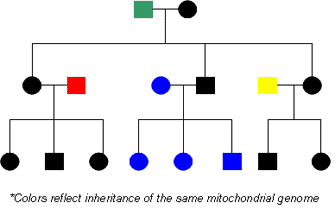What Are Characteristics of the Pedigrees of Families With Mitochondrial Diseases?

Figure 4: Inheritance of the maternal mitochondrial genome.
The mitochondrial genome is inherited from the mother in each generation.
Every bit previously mentioned, mitochondrial DNA in humans is always inherited from a person'due south mother (Figure four). As a result, we share our mitochondrial Dna sequence with our mothers, brothers, sisters, maternal grandmothers, maternal aunts and uncles, and other maternal relatives. Due to the loftier mutation rates associated with mitochondrial DNA, significant variability exists in mitochondrial Dna sequences among unrelated individuals. Yet, the mitochondrial Dna sequences of maternally related individuals, such every bit a grandmother and her grandson or granddaughter, are very similar and can be easily matched.
Mitochondrial DNA sequence data has proved extremely useful in man rights cases, as information technology is a great a tool for establishing the identity of individuals who have been separated from their families. This arroyo has been very successful for the following reasons (Owens et al., 2002; Schubert, 2003):
- A person's mitochondrial Dna sequence is shared with all of his or her maternal relatives, allowing a genetic match even with few surviving relatives.
- Mitochondrial Deoxyribonucleic acid varies greatly between unrelated families, but information technology should be nearly identical amongst closely related individuals.
- A given prison cell contains many more than copies of its mitochondrial Deoxyribonucleic acid than its nuclear DNA, which allows researchers to more easily obtain and analyze mitochondrial DNA samples from deceased relatives.
1 of the most prominent researchers to use mitochondrial DNA sequence data to tackle human rights issues is Dr. Mary-Claire King, who has undertaken such efforts in numerous countries, including Argentina, Croatia, El Salvador, Guatemala, Republic of haiti, Rwanda, United mexican states, Chile, Honduras, Ethiopia, and the Philippines (Owens et al., 2002; Schubert, 2003).
A specially interesting instance of Dr. King'due south work occurred in Argentina. Equally a result of a armed services dictatorship that overthrew the existing Argentinean authorities in 1976, thousands of citizens disappeared between 1976 and 1983, including infants and children who were abducted along with their parents. In addition, some children were born to women who were significant at the time of their kidnappings. After the military dictatorship was defeated, a new authorities commission predicted that at to the lowest degree 8,800 and perchance as many as 30,000 people had been kidnapped, including 220 documented infants and children. In 1977, the grandmothers of these orphans formed the Associacion de Abuelas de Plaza de Mayo in an attempt to identify their missing grandchildren, many of whom were illegally adopted by military families.
In 1984, King used mitochondrial Dna sequence data to reunite some of these Argentinean orphans with their grandmothers. King collected blood samples from orphaned children and from women who had lost their children and grandchildren. Using mitochondrial Dna sequence data, she so matched more than 60 orphans with their biological families. In fact, as recently every bit 1999, a young Argentinean human being named Guillermo was finally reunited with his grandmother and sister. Guillermo'south parents were kidnapped by security forces in October 1978; Guillermo'south mother, Patricia, was pregnant at the fourth dimension of her kidnapping, and Guillermo was built-in one calendar month later. Guillermo provided a blood sample to Rex'southward group, and his mitochondrial Dna sequence was a perfect match to that of one woman out of 2,000 in the database: Rosa, the mother of Patricia. As an boosted test, the researchers obtained a Dna sample from Mariana, the known daughter of Patricia, who was at a friend's house on the day her parents were kidnapped. Guillermo's mitochondrial DNA sequence was likewise a perfect match to that of Mariana (Owens et al., 2002; Schubert, 2003). Every bit shown by this example, mitochondrial Deoxyribonucleic acid sequences can be used to found family unit ties with maternal relatives, even when both of a person's parents are missing.
Source: http://www.nature.com/scitable/topicpage/mtdna-and-mitochondrial-diseases-903
0 Response to "What Are Characteristics of the Pedigrees of Families With Mitochondrial Diseases?"
Publicar un comentario